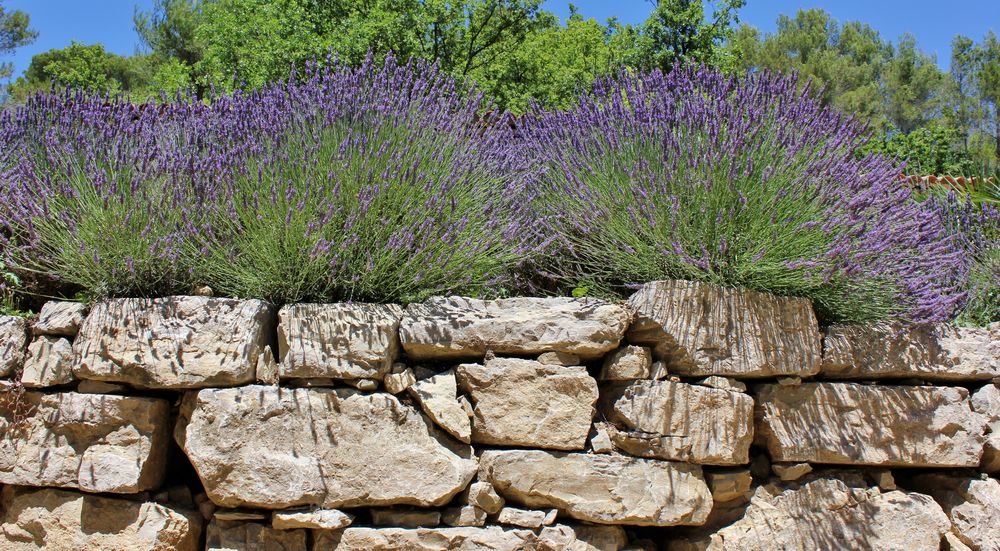Why you need qualified dry stone builders for your landscaping features
Dry stone builders unique know-how has a bright future as it interests both landscape designers and public authorities.

One of the lesser-known stone-working skills, dry stone builders work both in private gardens and on major public structures. Their trade has a bright future as it interests both landscape designers and public authorities! So let’s take a closer look at this unusual know-how with dry stone builder Bruno Schneider who specializes in the restoration of vernacular (i.e. local) architecture.

A dry stone wall in Provence, France
Dry stone builder, an artistic trade which sublimates dry stone
Dry stone builder possess the ancestral art of fitting dry stones together without binders or mortar. They build stone buttresses, field separations and whole buildings using a very specific technique.
Due to ignorance, this trade is often confused with stonecutting. Bruno Schneider explains that “each stone is used with its imperfections, which we transform into advantages. A bump in one will fit into a hollow in another. In fact, the stones guide us and not the other way round. This is why the key word in the trade of dry stone builder is ‘perseverance’: You have to start over until you find the right stone that’ll fit its neighbor.”
This know-how is immediately recognizable and results from a thousand-year-old technique, constantly improved by humans. Initially used to mark out fields precisely, it acquired a loftier vision and purpose you can still see in the Fortifications of Mycenae or on parts of the Great Wall of China. “Today, 15% of all road structures are built out of dry stone. We drive over them in vehicles weighing several tons without even noticing”.
A rare stone trade! There are only a several dozen full-time professional dry stone builders in France, but interest is reviving.
Discover natural stone trades with prospects
A job with prospects as dry stone solves current challenges
Because dry stone walls have up to 25% of voids, they act as thermal or water flow regulators like the stone walls in the south of France and Wales. Bruno Schneider regrets that “generally speaking people evacuate their run-off water onto their neighbor’s land. As a result, the inhabitants downstream suffer the most damage after storms. 99% of existing walls are roughcast, which makes them into dams. Due to pressure from the wet earth plus the pressure from the water flow, they breach without any warning signs.”
Dry stone walls are also ideal habitats for biodiversity, attracting lizards, lichens, insects and birds’ nests very quickly. They mirror the logic of sustainable development. Bruno Schneider told us that “we use local resources, create jobs that cannot be delocalized and after demolition our stone can be recycled infinitely. As we don’t use binders there is zero waste on our building sites and the only energy we consume is our own!”
A technique which takes a long-term view, because dry stone walls may show signs of their age but never collapse catastrophically. When bulging or displacement of stones appear, you only have to repair the damaged part instead of taking the whole wall down. “Everyone can contribute to safeguarding a wall built by a dry stone builder. When you’re out walking and you see a stone fallen from a wall, just replacing it increases the structure’s durability”. A well-built wall can easily live for several hundred years. The oldest walls yet found are 11,000 years old!
Dry stone builder are real assets for public authorities…
“Public authorities hesitate to call us in. However, we build problem-free supporting structures for agriculture and roads using a technique approved by a host of organizations, but the clients are always apprehensive,” notes Bruno Schneider.
However, the technique of the dry stone builder solves the great challenges of public spaces – rainwater management, the durability of new buildings and the protection of biodiversity and as an added bonus makes it possible for public authorities to meet blue-green infrastructure development objectives, which means, in France, they qualify for subsidies.
Read also: 6 main benefits of building in natural stone
Thanks to the “Climats du vignoble de Bourgogne” association, the walls registered in the perimeter of this UNESCO World Heritage site get financing for dry stone restoration. To transmit this invaluable know-how and protect their heritage, some public authorities have launched participative building sites. In 2019, the Lalbenque-Limogne community of communes created the “1,000 hands-on day” to restore the walls along the via Podiensis, one of the routes taken by pilgrims going to Santiago de Compostela.
… and also for landscapers!
In addition to being good-looking, the draining properties of dry stone make it ideal for features in private home and public authority grounds. A very interesting skill for professional landscapers to acquire.
“Landscape designers have an artistic vision and we have a more technical vision. We are not competitors, but complementary. We encourage professional landscapers to train in the use of dry stone and the FFPPS regularly organizes courses.” explains Bruno Schneider. “They need to understand what it is possible to do and how to convince their customers. They can then include a dry stone feature in their proposals for gardens. One solution is to subcontract an initial project to a professional Waller who will train their personnel on the job!”
Find out more about dry stone walling and features for gardens from November 30 to December 2, 2021 at Rocalia, by meeting sector professionals and attending dedicated conferences.
Visit Rocalia, the only natural stone trade show in France
Our thanks to Bruno Schneider for sharing his expertise with us.
© Photo credit: Jette Rasmussen / Adobe Stock




